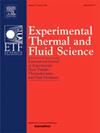大型垂直板上水射流冲击形成液膜特性及稳定性的实验研究
IF 3.3
2区 工程技术
Q2 ENGINEERING, MECHANICAL
Experimental Thermal and Fluid Science
Pub Date : 2025-07-08
DOI:10.1016/j.expthermflusci.2025.111563
引用次数: 0
摘要
本文对大型平板上射流撞击形成的液膜进行了实验研究。使用高速摄像机捕捉液体胶片的直接镜头,然后使用图像处理技术对其进行分析。研究重点确定了沿轴向不同位置液膜的厚度,考察了雷诺数在4250 ~ 8500范围内液膜下落的分布和波动特性。在不同入射角下进行了实验,研究了不同入射角对碰撞形成液膜厚度的影响。实验结果表明,液膜厚度随轴向距离的增加可分为三个阶段。随着入射雷诺数的增加,液膜的平均厚度和波动程度均增大,而厚度的增长率减小。此外,在流动过程中,液膜表面明显会被破坏,并区分出两种破坏模式。本文章由计算机程序翻译,如有差异,请以英文原文为准。
Experimental study of the characteristics and stability of liquid film formed by impinging of water jets on a large vertical plate
This paper presents an experimental investigation of the liquid film resulting from jet impingement on a large-scale flat plate. A high-speed camera was used to capture direct footage of the liquid film, which was then analyzed using image processing techniques. The study focused on determining the thickness of the liquid film at various positions along the axial direction and examining the distribution and fluctuation characteristics of the falling liquid film under Reynolds number ranging from 4250 to 8500. Experiments were conducted at different angles of incidence to investigate the influence of the incidence angle on the thickness of the liquid film formed by the collision. The experimental results show that the development of liquid film thickness with increasing axial distance is divided into three stages. As the incident Reynolds number increases, both the average thickness and the degree of fluctuation of the liquid film increase, while the growth rate of the thickness decreases. Furthermore, it is evident that the surface of the liquid film will be disrupted during the flow process, and two modes of disruption have been distinguished.
求助全文
通过发布文献求助,成功后即可免费获取论文全文。
去求助
来源期刊

Experimental Thermal and Fluid Science
工程技术-工程:机械
CiteScore
6.70
自引率
3.10%
发文量
159
审稿时长
34 days
期刊介绍:
Experimental Thermal and Fluid Science provides a forum for research emphasizing experimental work that enhances fundamental understanding of heat transfer, thermodynamics, and fluid mechanics. In addition to the principal areas of research, the journal covers research results in related fields, including combined heat and mass transfer, flows with phase transition, micro- and nano-scale systems, multiphase flow, combustion, radiative transfer, porous media, cryogenics, turbulence, and novel experimental techniques.
 求助内容:
求助内容: 应助结果提醒方式:
应助结果提醒方式:


